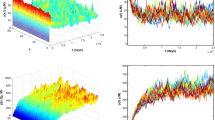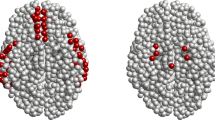Abstract
The misconformation and aggregation of the protein Amyloid-Beta (A\(\beta \)) is a key event in the propagation of Alzheimer’s Disease (AD). Different types of assemblies are identified, with long fibrils and plaques deposing during the late stages of AD. In the earlier stages, the disease spread is driven by the formation and the spatial propagation of small amorphous assemblies called oligomers. We propose a model dedicated to studying those early stages, in the vicinity of a few neurons and after a polymer seed has been formed. We build a reaction–diffusion model, with a Becker–Döring-like system that includes fragmentation and size-dependent diffusion. We hereby establish the theoretical framework necessary for the proper use of this model, by proving the existence of solutions using a fixed point method.


Similar content being viewed by others
References
Andrade-Restrepo M, Lemarre P, Pujo-Menjouet L, Tine LM, Ciuperca SI (2020) Modeling the spatial propagation of A\(\beta \) oligomers in Alzheimer’s Disease. In: ESAIM: ProcS, numerical and mathematical modeling for biological and medical applications: deterministic,probabilistic and statistic description, EDP Sciences, vol 67, pp 30–45. https://doi.org/10.1051/proc/202067003
Bertsch M, Franchi B, Marcello N, Tesi MC, Tosin A (2016) Alzheimer’s disease: a mathematical model for onset and progression. Math Med Biol: J IMA 34(2):193–214
Bertsch M, Franchi B, Tesi MC, Tosin A (2017) Microscopic and macroscopic models for the onset and progression of Alzheimer’s disease. J Phys A: Math Theor 50(41):414003
Carbonell F, Iturria-Medina Y, Evans AC (2018) Mathematical modeling of protein misfolding mechanisms in neurological diseases: a historical overview. Front Neurol 9:37
Ciuperca IS, Dumont M, Lakmeche A, Mazzocco P, Pujo-Menjouet L, Rezaei H, Tine LM (2018) Alzheimer’s disease and prion: analysis of an in vitro mathematical model. Discrete Contin Dyn Syst-Ser B
Čižas P, Jekabsone A, Borutaite V, Morkūniene R (2011) Prevention of amyloid-beta oligomer-induced neuronal death by EGTA, estradiol, and endocytosis inhibitor. Medicina 47(2):15
Cohen SI, Linse S, Luheshi LM, Hellstrand E, White DA, Rajah L, Otzen DE, Vendruscolo M, Dobson CM, Knowles TP (2013) Proliferation of Amyloid-\(\beta \)42 aggregates occurs through a secondary nucleation mechanism. Proc Natl Acad Sci 110(24):9758–9763
Doumic M, Goudon T, Lepoutre T (2009) Scaling limit of a discrete prion dynamics model. Commun Math Sci 7(4):839–865
Eigen M (1996) Prionics or the kinetic basis of prion diseases. Biophys Chem 63(1):A1–A18
Eleuteri S, Di Giovanni S, Rockenstein E, Mante M, Adame A, Trejo M, Wrasidlo W, Wu F, Fraering PC, Masliah E et al (2015) Blocking A\(\beta \) seeding-mediated aggregation and toxicity in an animal model of Alzheimer’s Disease: A novel therapeutic strategy for neurodegeneration. Neurobiol Dis 74:144
Elliott C, Rojo AI, Ribe E, Broadstock M, Xia W, Morin P, Semenov M, Baillie G, Cuadrado A, Al-Shawi R et al (2018) A role for APP in Wnt signalling links synapse loss with \(\beta \)-amyloid production. Transl Psychiatry 8(1):179
Greer ML, Pujo-Menjouet L, Webb GF (2006) A mathematical analysis of the dynamics of prion proliferation. J Theor Biol 242(3):598–606
Haass C, Selkoe DJ (2007) Soluble protein oligomers in neurodegeneration: lessons from the Alzheimer’s amyloid \(\beta \)-peptide. Nat Rev Mol Cell Biol 8(2):101
Hardy J (2003) The relationship between amyloid and tau. J Mol Neurosci 20(2):203–206
Hardy JA, Higgins GA (1992) Alzheimer’s disease: the amyloid cascade hypothesis. Science 256(5054):184–186
Harper JD, Lansbury PT Jr (1997) Models of amyloid seeding in alzheimer’s disease and scrapie: mechanistic truths and physiological consequences of the time-dependent solubility of amyloid proteins. Annu Rev Biochem 66(1):385–407
Helal M, Hingant E, Pujo-Menjouet L, Webb GF (2014) Alzheimer’s disease: analysis of a mathematical model incorporating the role of prions. J Math Biol 69(5):1207–1235
Helal M, Igel-Egalon A, Lakmeche A, Mazzocco P, Perrillat-Mercerot A, Pujo-Menjouet L, Rezaei H, Tine LM (2018) Stability analysis of a steady state of a model describing Alzheimer’s disease and interactions with prion proteins. J Math Biol pp 1–25
Hiltunen M, van Groen T, Jolkkonen J (2009) Functional roles of amyloid-\(\beta \) protein precursor and amyloid-\(\beta \) peptides: evidence from experimental studies. J Alzheimers Dis 18(2):401–412
Ittner LM, Götz J (2011) Amyloid-\(\beta \) and tau–a toxic pas de deux in Alzheimer’s disease. Nat Rev Neurosci 12(2):67
Jack CR Jr, Knopman DS, Jagust WJ, Petersen RC, Weiner MW, Aisen PS, Shaw LM, Vemuri P, Wiste HJ, Weigand SD et al (2013) Tracking pathophysiological processes in Alzheimer’s disease: an updated hypothetical model of dynamic biomarkers. Lancet Neurol 12(2):207–216
Lions JL, Magenes E (1972) Non-homogeneous boundary value problems and applications, vol 1. Springer, Berlin
Matthaeus F (2009) The spread of prion diseases in the brain models of reaction and transport networks. J Biol Syst 17(04):623–641
Matthäus F (2006) Diffusion versus network models as descriptions for the spread of prion diseases in the brain. J Theor Biol 240(1):104–113
Morales R, Duran-Aniotz C, Castilla J, Estrada L, Soto C (2012) De novo induction of amyloid-\(\beta \) deposition in vivo. Mol Psychiatry 17(12):1347
Nowak MA, Krakauer DC, Klug A, May RM (1998) Prion infection dynamics. Integrative Biology: Issues, News, and Reviews: Published in Association with The Society for Integrative and Comparative Biology 1(1):3–15
Oda T, Pasinetti G, Osterburg H, Anderson C, Johnson S, Finch C (1994) Purification and characterization of brain clusterin. Biochem Biophys Res Commun 204(3):1131–1136. https://doi.org/10.1006/bbrc.1994.2580
Oda T, Wals P, Osterburg HH, Johnson SA, Pasinetti GM, Morgan TE, Rozovsky I, Stine W, Snyder SW, Holzman TF, Krafft GA, Finch CE (1995) Clusterin (apoJ) alters the aggregation of amyloid \(\beta \)-Peptide (A\(\beta \)1-42) and forms slowly sedimenting A\(\beta \) complexes that cause oxidative stress. Exp Neurol 136(1):22–31. https://doi.org/10.1006/exnr.1995.1080
Ohm T, Müller H, Braak H, Bohl J (1995) Close-meshed prevalence rates of different stages as a tool to uncover the rate of Alzheimer’s disease-related neurofibrillary changes. Neuroscience 64(1):209–217
Olsson TT, Klementieva O, Gouras GK (2018) Prion-like seeding and nucleation of intracellular amyloid-\(\beta \). Neurobiol Dis 113:1–10
Perrin RJ, Fagan AM, Holtzman DM (2009) Multimodal techniques for diagnosis and prognosis of Alzheimer’s disease. Nature 461(7266):916
Raj A, Kuceyeski A, Weiner M (2012) A network diffusion model of disease progression in dementia. Neuron 73(6):1204–1215
Rasmussen J, Jucker M, Walker LC (2017) A\(\beta \) seeds and prions: how close the fit? Prion 11(4):215–225
Sengupta U, Nilson AN, Kayed R (2016) The role of amyloid-\(\beta \) oligomers in toxicity, propagation, and immunotherapy. EBioMedicine 6:42–49
Smith AD (2002) Imaging the progression of Alzheimer pathology through the brain. Proc Natl Acad Sci 99(7):4135–4137
Soto C (2003) Unfolding the role of protein misfolding in neurodegenerative diseases. Nat Rev Neurosci 4(1):49
Sowade RF, Jahn TR (2017) Seed-induced acceleration of amyloid-\(\beta \) mediated neurotoxicity in vivo. Nat Commun 8(1):512
Storandt M, Grant EA, Miller JP, Morris JC (2002) Rates of progression in mild cognitive impairment and early Alzheimer?s disease. Neurology 59(7):1034–1041
Stumpf MP, Krakauer DC (2000) Mapping the parameters of prion-induced neuropathology. Proc Natl Acad Sci 97(19):10573–10577
Vasseur A, Poupaud F, Collet JF, Goudon T (2002) The Beker–Döring System and Its Lifshitz–Slyozov Limit. SIAM J Appl Math 62(5):1488–1500
Velázquez J (1998) The Becker–Döring equations and the Lifshitz–Slyozov theory of coarsening. J Stat Phys 92(1–2):195–236
Xiao T, Zhang W, Jiao B, Pan CZ, Liu X, Shen L (2017) The role of exosomes in the pathogenesis of Alzheimer’s disease. Transl Neurodegeneration 6(1):3
Yankner BA (1996) Mechanisms of neuronal degeneration in Alzheimer’s disease. Neuron 16(5):921–932
Zhao LN, Long HW, Mu Y, Chew LY (2012) The toxicity of amyloid ß oligomers. Int J Mol Sci 13(6):7303–7327
Author information
Authors and Affiliations
Corresponding author
Ethics declarations
Conflict of interest
The authors declare that they have no conflict of interest.
Additional information
Publisher's Note
Springer Nature remains neutral with regard to jurisdictional claims in published maps and institutional affiliations.
Rights and permissions
About this article
Cite this article
Andrade-Restrepo, M., Ciuperca, I.S., Lemarre, P. et al. A reaction–diffusion model of spatial propagation of A\(\beta \) oligomers in early stage Alzheimer’s disease. J. Math. Biol. 82, 39 (2021). https://doi.org/10.1007/s00285-021-01593-3
Received:
Revised:
Accepted:
Published:
DOI: https://doi.org/10.1007/s00285-021-01593-3




